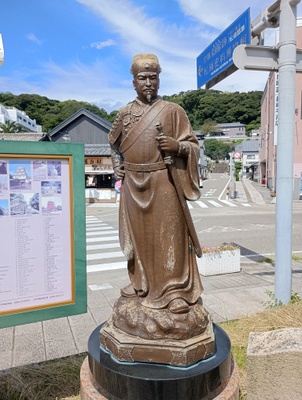Zheng Chenggong

- Born: 1624
- Died: 1662
- Other Names: 国姓爺 (Coxinga/Koxinga, C: Guóxìngyé, J: Kokusen'ya),[1] 和唐内、和藤内 (J: Watounai), 田川福松 (Takawa Fukumatsu)
- Chinese/Japanese: 鄭成功 (Zhèng Chéng gōng / Tei Seikou)
Zheng Chenggong was a Ming loyalist and pirate based on Taiwan. He is often referred to in Western-language sources as Coxinga or Koxinga, a corruption of his epithet Guóxìngyé.
Life and Career
Born in Hirado to a Japanese mother named Takawa Matsu,[2], he sailed alongside his father, the pirate-lord Zheng Zhilong, in harassing the ships and bases of the Dutch East India Company, as well as wealthy Chinese merchants and Ming Dynasty governmental targets.
He inherited control of his father's network of maritime trade, pirate bands, and bases of operation, and after the fall of the Ming to Manchu invaders in 1644, put these to work rebelling against the new Qing Dynasty by attacking coastal shipping and other targets. Under his command, Amoy (Xiamen) became a bustling international entrepot, where Zheng oversaw ten trading companies dealing in goods ranging from sugar and silk to gunpowder.[3] Around this time, Zheng gained the favor of the Longwu Emperor of the Southern Ming, who bestowed upon him the Ming Imperial surname Zhu, and the honorary title "Guóxìngyé" (roughly, "Lord bearing the Imperial Surname").[2] The loyalists lost Fuzhou, their last foothold on the Chinese mainland, in 1646, but then worked to consolidate their position on Taiwan. That same year, Chenggong's father turned to support the Qing, and began working to convince Chenggong to give up the resistance.[4]
The Qing government attempted to blockade Taiwan in 1656, but were largely ineffective; the following year, they imposed a policy known as qianjie, forcing Chinese to retreat inland, emptying the coastal regions of southern China in order to deny Coxinga targets to attack. Suffering a considerable defeat by the Qing at Nanjing in 1659, Coxinga fell back to Taiwan.[5]
His father was executed in Beijing in 1661,[4] his mother having been killed some years earlier by the Qing.[3] The following year, Chenggong solidified his position on Taiwan by seizing the Dutch fortress, and driving the Dutch off the island. They successfully negotiated with him to be allowed to return safely to Batavia (rather than be killed or captured), but left behind goods and cash worth over one million ounces of silver.[3] Zheng Chenggong died later that year,[5] but his successors managed to hold out against Qing forces until 1683. Following their defeat, Zheng's descendants were treated relatively well by the Qing government, with some even being ennobled and settled in Beijing. Many of their followers were absorbed into the Manchu military, being assigned to garrisons on the Russian border or elsewhere.[6]
Chenggong's son Zheng Jing returned to the Chinese mainland, and fought under Wu Sangui in the Revolt of the Three Feudatories.[7]
Legacy
Zheng Chenggong is celebrated in numerous legends and stories. In Japan, the most prominent of these is Chikamatsu's 1715 ningyô jôruri (puppet theatre) play The Battles of Coxinga, the first puppet play to ever be adapted to the kabuki stage. In the play, the character of Coxinga is named Watônai, literally meaning "between Japan and China," a reference to Coxinga's birth.
Though regarded as an enemy of the state for over two centuries in Qing Dynasty China, he became honored by the Qing as a hero in 1875. This was probably done in response to the Japanese invasion of Taiwan the previous year, as part of discursive efforts to claim Taiwan, and its history, for China.[5]
References
- Matt Matsuda, Pacific Worlds, University of Cambridge Press (2012), 109.
- ↑ Though granted the title "Guóxìngyé" 国姓爺 (roughly, "Lord bearing the National [i.e. Imperial] Surname") historically, the Japanese play The Battles of Coxinga changes this to 国性爺 (roughly, "Lord bearing National Character").
- ↑ 2.0 2.1 Yamagata Kin'ya 山形欣哉, Rekishi no umi wo hashiru 歴史の海を走る, Nôsangyoson bunka kyôkai (2004), 166.
- ↑ 3.0 3.1 3.2 Jonathan Spence, The Search for Modern China, Second Edition, W.W. Norton & Co. (1999), 55.
- ↑ 4.0 4.1 Marius Jansen, China in the Tokugawa World, Harvard University Press (1992), 26-27.
- ↑ 5.0 5.1 5.2 Jansen, 85.
- ↑ Spence, 56.
- ↑ Schottenhammer, Angela. “Empire and Periphery? The Qing Empire’s Relations with Japan and the Ryūkyūs (1644–c. 1800), a Comparison.” The Medieval History Journal 16, no. 1 (April 1, 2013): 159.